CompositesWorld News for Dec. 04, 2019
Read news from ELG Carbon Fibre, GKN Aerospace, MIKROSAM, Solvay Composite Materials, and SGL Carbon SE
Britannia boat cradles manufactured with ELG recycled carbon fiber
ELG Carbon Fibre has processed more than 1.2 metric tonnes of INEOS Team UK’s carbon fiber waste materials to produce two cradles for the new race boat.
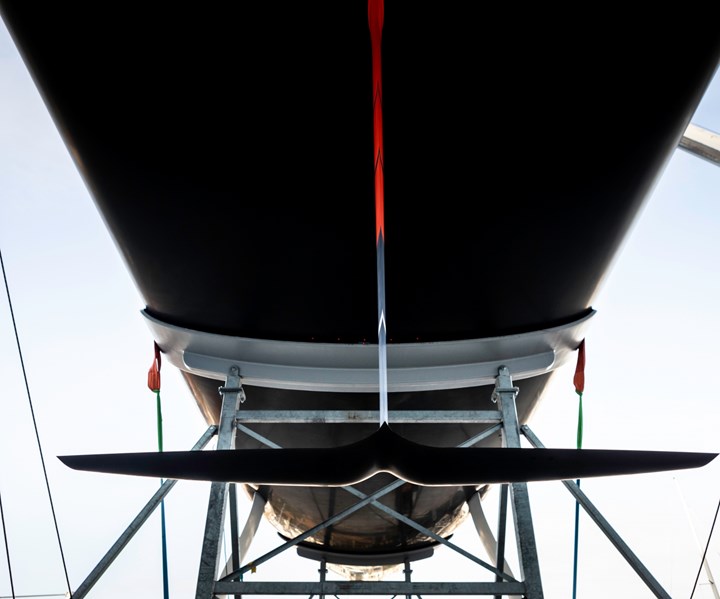
Source | ELG Carbon Fibre Ltd.
ELG Carbon Fibre (ELG; Coseley, U.K.) has announced that, in a partnership with INEOS Team UK (Portsmouth, U.K.), it has processed more than 1.2 metric tonnes of the team’s carbon fiber waste materials and used them to produce two cradles for the new race boat Britannia. INEOS Team UK’s waste was composed of pre-impregnated and cured parts from the current campaign, which ELG has subsequently reprocessed into thermoset and thermoplastic compounds and nonwoven mats. Molds for the hull regions of the team’s test boats have also been manufactured using the same technology, ELG says.
Britannia was officially launched in October at the INEOS Team UK’s headquarters in Portsmouth. The 75-foot foiling monohull is reportedly the first of its size, requiring a strong and stable cradle to support the boat in transit.
ELG’s nonwoven carbon fiber mats were used to produce the curved cradles the hull sits upon. The company’s technical service engineers provided guidance about the specific processing requirements for these materials. Vacuum infusion was selected as the most economic method for manufacturing these parts, although ELG says its materials can also be used in prepreg and liquid compression molding processes. ELG’s products were also incorporated into the hull mold, which was made using a vacuum infusion process.
“ELG’s technology was ideal for the cradles application. Their recycled materials are easy to handle, perform well and fitted straight into our production processes,” says Alan Boot, naval architect at INEOS Team UK. “As an America’s Cup Team we hope to lead the way showing other manufacturers you can avoid putting materials in landfill, close the loop and reuse the fibers with stunning results. This is a game changing approach to marine manufacturing that we are delighted to be part of.”
For more on recycled carbon fiber, read about the current state of recycled carbon fiber, listen to a podcast episode about the market for recovered fibers, or read a guest column about the challenge of identifying test procedures for recycled carbon fiber composites.
Composite Builders named supplier for Firefly Aerospace
Composite Builders to supply carbon fiber components for use on Firefly Aerospace launch vehicles.
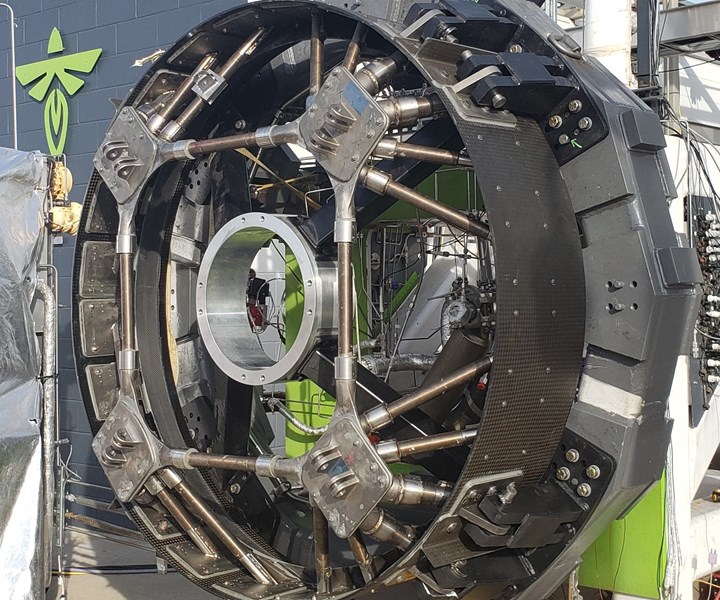
Thrust structure for Firefly’s Reaver engines Source | Firefly Aerospace
Composite Builders (Holland, Mich., U.S.) has been approved as a supplier for in-space mobility vehicle company Firefly Aerospace Inc. (Austin, Texas, U.S.). Composite Builders will supply carbon fiber components for use on Firefly’s space vehicles.
Firefly’s launch vehicles utilize common technologies, manufacturing infrastructure and launch capabilities, providing low earth orbit (LEO) launch solutions for up to four metric tons of payload. Combined with Firefly's in-space services, Firefly provides the space industry with access to frequent launches at the lowest cost/kg, enabling ambitious commercial and exploration missions from LEO to the Moon.”
Composite Builders is registered under ISO 9001;2015 and uses AS 9100 documentation in their processes.
“We understand every decision made for the lamination process and how carbon fiber will perform per skin,” says Carbon Builders CEO Brian MacInnes. “There are also important external factors we control that can affect pre-impregnated carbon fiber, such as material processing, exposure, contaminates, and temperature.”
MacInnes started Composite Builders in 2014 after a thirty-plus year career working in the marine industry building pre-impregnated structures, molds and boats, and competing in numerous world championships, culminating in two America’s Cup victories. Its background in using advanced fiber technology in elite yacht racing has positioned Composite Builders to support companies like Firefly who are driving advancements in the mobility market.
Multifunctional composites could help achieve structural supercapacitors for EVs
Functionalized graphene/nanofiber electrodes showed 2X modulus, strength and 5-10X multifunctional efficiency.

Structural batteries and structural supercapacitors offer a potential solution for electric vehicles (EVs) because they can not only handle structural loads but also store energy and/or produce power. For future ground and air mobility, this offers reduced weight and volume for structures and batteries, as well as more miles between recharging. However, current electrodes for batteries and supercapacitors suffer from poor mechanical performance because they are typically made from brittle materials.
A team led by Texas A&M University (College Station, Tex. U.S.) chemical engineer, Jodie Lutkenhaus, has produced structural supercapacitor electrodes using reduced graphene oxide (rGO), innovative chemistry and aramid nanofibers to mimic the natural material nacre, achieving Young’s modulus and ultimate tensile strength that are 220% and 255%, respectively, higher versus pure rGO electrodes, as well as multifunctional efficiency values of 5–13.6 compared to current electrodes at <1.
Nacre-like multifunctional composite
In an article published in the journal Matter, Lutkenhaus and her team describe using dopamine to functionalize (chemically bond to) rGO and then combine this material with aramid nanofibers to form a composite. The paper explains, “We hypothesized that nature-inspired materials could transform the poor mechanical properties of supercapacitor electrodes into those mimicking nacre, bone, or wood to realize exceptionally high values of multifunctional efficiency.”
Nacre (mother-of-pearl) consists of 95 vol % aragonite (calcium carbonate), chitin, and proteins yet exhibits toughness three orders of magnitude higher than aragonite alone. Its superior mechanical performance results from its hierarchical composite structure: its constituent particles and matrix are organized differently at each geometric scale or level (e.g., nano-, micro-, meso-, macro-) and combine with efficient interfaces between these levels to achieve high modulus and strength while mitigating crack propagation (see the blog “Magnetic 3D printing the next generation of tailored composites”).
The Lutkenhaus team knew that graphene-based nacre-mimicking electrodes have been shown to perform very well electrically. The challenge was to improve their mechanical properties. The team sought to use the hormone and neurotransmitter dopamine to functionalize rGO. Dopamine also self-polymerizes into the highly adhesive polymer polydopamine (PDA). Dopamine mimics the structure of adhesive proteins in nacre-lined mussels, while PDA has been utilized in Li-ion batteries and supercapacitors as an electrode material, separator modifier and binder. However, only a handful of studies have focused on incorporating PDA in rGO composites.
As explained in the Matter technical paper, “We sought to combine for the first time the excellent mechanical properties of PDA-modified rGO with high-modulus, high-tensile-strength Kevlar aramid nanofiber to improve the multifunctional efficiency.” Aramid nanofibers have also been used in a variety of applications including energy storage.
Good structural properties
Nacre-mimicking structural supercapacitor electrodes based on branched aramid nanofibers and dopamine-functionalized rGO sheets were fabricated using vacuum filtration and their performance was evaluated. The excellent mechanical properties exhibited are reported to result from increased hydrogen bonding caused by the dopamine functionalization and chelation caused by Ca2+ ions.
The Lutkenhaus team reports that this approach is applicable to other nacre-mimicking structures which should lead to a new stronger multifunctional family of nature-inspired materials. “Future work should focus on improving the electrochemical performance, either by adding porosity to improve the ionic mobility or by adding a pseudocapacitive material to enhance energy density. To the best of our knowledge, the obtained Young's modulus and multifunctional efficiency is the highest among the electrically conductive composites with low aramid nanofiber content. This leads to strong structural supercapacitor electrodes with high electrochemical performance.”
Mikrosam to supply GKN Fokker with AFP, consolidation equipment for thermoplastic composites
The suite of equipment includes Mikrosam’s latest automated fiber placement (AFP) machine, slitting equipment for thermoplastic prepregs and a custom-engineered thermoplastic consolidating machine.
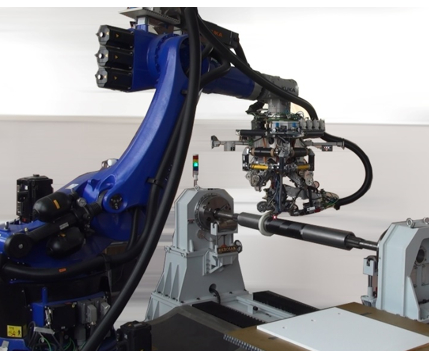
Source | Mikrosam
Mikrosam (Prilep, Macedonia) announced on Dec. 3 that it will deliver advanced equipment to GKN Fokker (Redditch, U.K.) for development of thermoplastic composite (TPC) aircraft parts. The suite of equipment includes Mikrosam’s latest automated fiber placement (AFP) machine, slitting equipment for thermoplastic prepregs and a custom-engineered thermoplastic consolidating machine. When installed, the company says this equipment will add to GKN Fokker’s advanced manufacturing and R&D capabilities to produce complex 3D parts for the aviation industry.
Mikrosam says its AFP solutions for thermoplastic composites are cost-competitive and proven, with many advancements for maximum productivity. Designed as an integrated, modular and upgradeable AFP work-cell, the 8-axis robotic AFP machine is reportedly capable of automated and precise placement of thermoplastic fibers.
The system uses a multi-material AFP head with bi-directional placement on open and closed 3D shapes and mandrel surfaces. Combined with an automatic head exchange system, customers can obtain new multi-tow AFP or automated tape laying (ATL) heads, or additional equipment for future use on the same work cell. Mikrosam’s AFP heads are also designed with flexibility and time-saving features, such as easy access to material spools, and quick servicing of consumable and spare parts with minimized downtimes to ensure high reliability, productivity and flexibility in advanced composites manufacturing. Using a laser heating source, precise temperature and angle control, and a closed-loop process, Mikrosam’s AFP machines are reported to have proven results for in-situ consolidation of TPCs with better mechanical properties.
In addition to the AFP system, GKN Fokker will receive equipment for wide and narrow prepreg tape slitting and rewinding to prepare spools. According to Mikrosam, the slitting and rewinding machine works with thermoplastic prepregs to produce spools of various sizes and re-winding styles, ranging from 300-millimeter-wide tape to ¼-inch-wide tapes. Additionally, Mikrosam will deliver a custom-engineered consolidation press for advanced products made of thermoplastic composites. The complete automation of the AFP machine is powered by MikroPlace, a CATIA-compatible solution for analysis and simulation of composite parts, as well as QCS (Quality Control System), which offers continuous improvement via data monitoring and traceability. Read more about this and other recent advances in AFP/ATL software.
“Today, the market demands better automated thermoplastics layup and higher utilization of AFP machines. Our modular, upgradeable AFP systems give customers higher ROI with the ability to use multiple AFP or ATL heads on the same configuration. Customers can reduce cycle-times for parts and increase utilization of the AFP work cell. When combined with our sophisticated control for in-situ consolidation of thermoplastic composites, our AFP machines provide excellent solutions for many industries,” says Dimitar Bogdanoski, sales manager at Mikrosam DOO.
“We are pleased by Mikrosam’s professionalism and innovative drive, as well as the quality of the machines,” says Arnt Offringa, thermoplastic composites technology manager at GKN Aerospace.
Read more about the evolving role of thermoplastic materials and processes, and their future in next-generation commercial aircraft.
Solvay, SGL to develop large-tow carbon fiber materials for aerostructures
The joint development agreement (JDA) intends to bring to market the first composite materials for commercial aerostructures based on large-tow intermediate modulus (IM) carbon fiber.
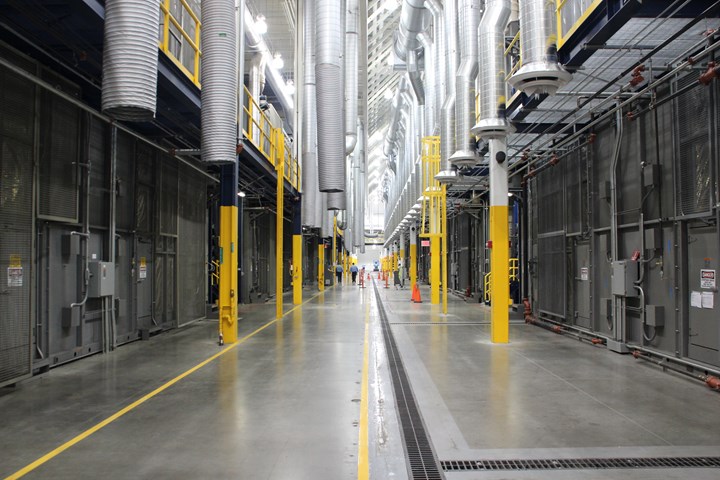
Carbon fiber production line at SGL Carbon’s multi-line facility in Moses Lake, Wash., U.S. The plant, originally established to make carbon fiber for BMW, produces 50k tow carbon fibers. Source: SGL Carbon. Source | SGL Carbon
Specialty chemicals giant Solvay (Brussels, Belgium) and carbon fiber manufacturer SGL Carbon (Wiesbaden, Germany) reported on Dec. 3 that they have entered into a joint development agreement (JDA) to bring to market the first composite materials based on large-tow intermediate modulus (IM) carbon fiber. These materials, which help address the need to reduce costs and CO2 emissions, and improve the production process and fuel efficiency of next-generation commercial aircraft, will be based on SGL Carbon’s large-tow IM carbon fiber and Solvay’s primary structure resin systems.
The agreement encompasses thermoset and thermoplastic composite technologies. It builds on Solvay’s position as a supplier of advanced materials to the aerospace industry and SGL Carbon’s expertise in high-volume carbon fiber manufacturing.
“For Solvay, this is an opportunity to lead the aerospace adoption of a composite material based on 50k IM carbon fiber. This is a highly competitive value proposition that brings more affordable high- performance solutions to our customers. We see this as the first step in a long-term partnership,” says Augusto Di Donfrancesco, member of Solvay’s executive committee.
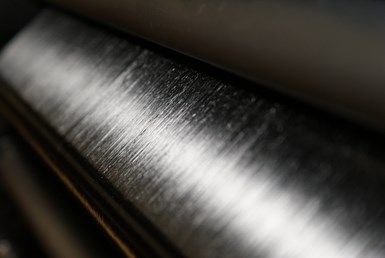
Closeup of SGL Carbon carbon fiber. Source | SGL Carbon
“By combining SGL’s carbon fiber expertise in our newly developed, unique 50k IM fiber with Solvay’s resin formulation and aerospace market expertise, both partners are aiming to develop an advanced aerospace material system. This alliance supports our strategic direction and accelerates our growth in the attractive aerospace market,” said Dr. Michael Majerus, spokesman of the management board of SGL Carbon.
Composite materials for aerospace applications represent a multi-billion-dollar market that is expected to grow strongly in the coming decade. Solvay and SGL Carbon are uniquely positioned to develop solutions to address the needs of this market.
Related Content
Materials & Processes: Fabrication methods
There are numerous methods for fabricating composite components. Selection of a method for a particular part, therefore, will depend on the materials, the part design and end-use or application. Here's a guide to selection.
Read MoreThe state of recycled carbon fiber
As the need for carbon fiber rises, can recycling fill the gap?
Read MoreA new era for ceramic matrix composites
CMC is expanding, with new fiber production in Europe, faster processes and higher temperature materials enabling applications for industry, hypersonics and New Space.
Read MoreCarbon fiber in pressure vessels for hydrogen
The emerging H2 economy drives tank development for aircraft, ships and gas transport.
Read MoreRead Next
CW’s 2024 Top Shops survey offers new approach to benchmarking
Respondents that complete the survey by April 30, 2024, have the chance to be recognized as an honoree.
Read MoreFrom the CW Archives: The tale of the thermoplastic cryotank
In 2006, guest columnist Bob Hartunian related the story of his efforts two decades prior, while at McDonnell Douglas, to develop a thermoplastic composite crytank for hydrogen storage. He learned a lot of lessons.
Read MoreComposites end markets: Energy (2024)
Composites are used widely in oil/gas, wind and other renewable energy applications. Despite market challenges, growth potential and innovation for composites continue.
Read More





























